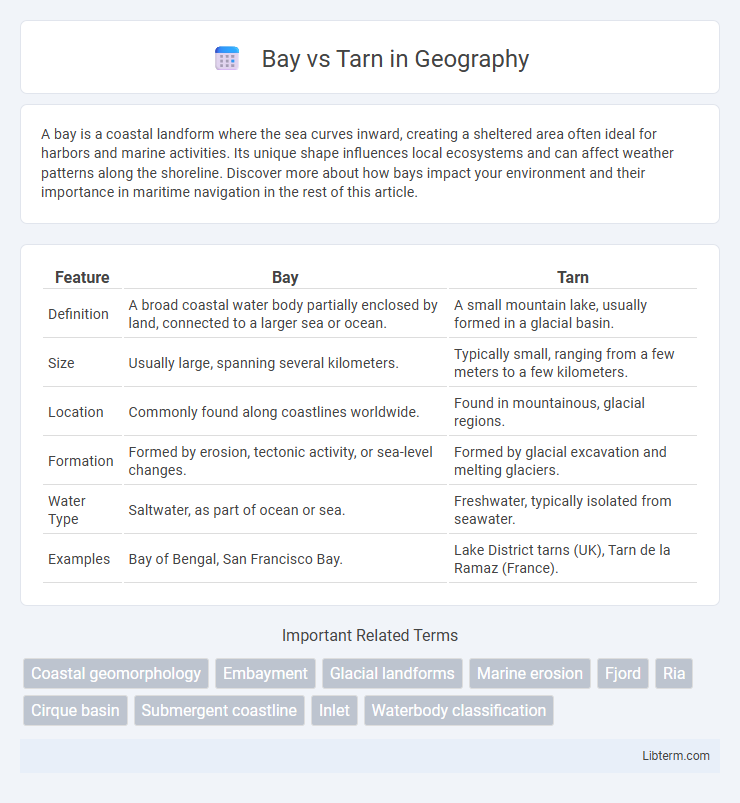A bay is a coastal landform where the sea curves inward, creating a sheltered area often ideal for harbors and marine activities. Its unique shape influences local ecosystems and can affect weather patterns along the shoreline. Discover more about how bays impact your environment and their importance in maritime navigation in the rest of this article.
Table of Comparison
| Feature | Bay | Tarn |
|---|---|---|
| Definition | A broad coastal water body partially enclosed by land, connected to a larger sea or ocean. | A small mountain lake, usually formed in a glacial basin. |
| Size | Usually large, spanning several kilometers. | Typically small, ranging from a few meters to a few kilometers. |
| Location | Commonly found along coastlines worldwide. | Found in mountainous, glacial regions. |
| Formation | Formed by erosion, tectonic activity, or sea-level changes. | Formed by glacial excavation and melting glaciers. |
| Water Type | Saltwater, as part of ocean or sea. | Freshwater, typically isolated from seawater. |
| Examples | Bay of Bengal, San Francisco Bay. | Lake District tarns (UK), Tarn de la Ramaz (France). |
Understanding Bays and Tarns: Key Definitions
A bay is a coastal body of water partially enclosed by land with a wide mouth, often providing safe anchorage and supporting diverse marine ecosystems. A tarn is a small mountain lake formed in a cirque excavated by a glacier, typically found in high-altitude regions with clear, cold water. Bays influence coastal weather patterns and human activities like shipping, while tarns offer unique habitats and serve as indicators of past glacial activity.
Geographical Formation of Bays
Bays are coastal water bodies partially enclosed by land, formed through various geological processes such as erosion, tectonic activity, and sea level changes. Unlike tarns, which are small mountain lakes formed by glacial activity in cirques, bays typically develop along shorelines where softer rock erodes faster than surrounding areas, creating indented coastlines. This differential erosion combined with sediment deposition shapes bays, resulting in wide, open water inlets connected to larger bodies like oceans or seas.
Geological Origins of Tarns
Tarns are small mountain lakes formed in glacially carved cirques, typically found in alpine regions where past glaciation sculpted the landscape. Unlike bays, which are coastal water bodies formed by the submergence of river valleys or coastal erosion, tarns originate from glacial processes including ice accumulation, movement, and subsequent melting that excavate bedrock basins. The geological origin of tarns is therefore closely tied to Pleistocene glaciations, which created depressions through plucking and abrasion, later filled with meltwater to establish these distinctive freshwater bodies.
Physical Characteristics: Bay vs Tarn
Bays are expansive coastal inlets characterized by their wide openings to the sea, often featuring deep water and gently sloping shores, facilitating navigation and marine habitats. Tarns are small mountain lakes or pools formed in cirques carved by glaciers, typically exhibiting clear, cold water nestled in high-altitude basins with steep surrounding cliffs. The contrasting physical features of bays and tarns reflect their distinct geological origins and environments, influencing their size, shape, and ecological roles.
Ecological Roles in their Respective Environments
Bays serve as critical nurseries for marine life, providing sheltered waters that support diverse ecosystems and facilitate nutrient cycling. Tarns, typically formed in glacial depressions, act as freshwater reservoirs supporting unique alpine flora and fauna adapted to cold, oligotrophic conditions. Both ecosystems contribute to biodiversity conservation by maintaining specialized habitats essential for various species' life cycles.
Human Interaction and Utilization
Bay ecosystems serve as crucial hubs for human interaction, supporting activities such as fishing, transportation, and tourism due to their calm waters and nutrient-rich environments. Tarn lakes, formed by glacial activity and typically located in mountainous regions, are often less accessible but prized for recreational uses like hiking, swimming, and conservation efforts. Both bays and tarns illustrate the diverse ways humans utilize aquatic environments, balancing economic benefits with ecological preservation.
Famous Bays Around the World
Famous bays around the world such as Bay of Bengal, San Francisco Bay, and Sydney Harbour showcase diverse ecosystems and attract millions of tourists annually. These bays are distinguished from tarns, which are smaller, mountain lakes formed by glacial activity and typically found in alpine regions. Bays serve as crucial hubs for maritime trade, biodiversity, and coastal communities, unlike tarns which mainly offer scenic natural beauty and freshwater habitats.
Notable Tarns and Their Locations
Notable tarns such as Red Tarn in the Lake District and Tarn Hows in Cumbria are renowned for their scenic beauty and accessibility, drawing visitors for hiking and photography. Red Tarn, situated below Helvellyn, is a glacially-formed mountain lake offering dramatic alpine views, while Tarn Hows represents a curated natural spot managed by the National Trust. These tarns highlight the distinct geological formations and recreational importance of tarns compared to bays, which are larger coastal water bodies.
Environmental Threats: Bay vs Tarn
Bays face environmental threats such as pollution from urban runoff, sedimentation, and habitat loss due to coastal development, impacting marine biodiversity and water quality. Tarns, often located in mountainous or glacial regions, are threatened by climate change resulting in altered water temperatures and reduced ice cover, which affect native aquatic species and ecosystem balance. Both water bodies require targeted conservation efforts to mitigate pollution, climate impacts, and preserve their unique ecological functions.
Choosing Between Bay and Tarn for Tourism and Recreation
Bay offers diverse marine activities such as kayaking, fishing, and boat tours, making it ideal for tourists seeking water-based recreation. Tarn, characterized by its calm freshwater environment and scenic hiking trails, attracts visitors interested in tranquil nature experiences and wildlife observation. Selecting between Bay and Tarn depends on the preference for either vibrant coastal ecosystems or serene inland landscapes for outdoor activities.
Bay Infographic

 libterm.com
libterm.com